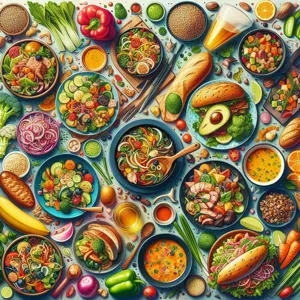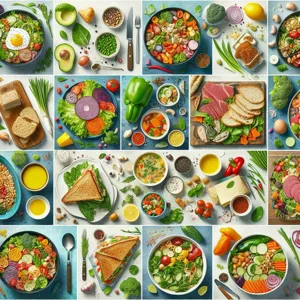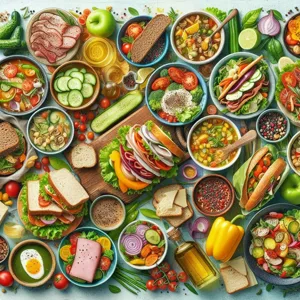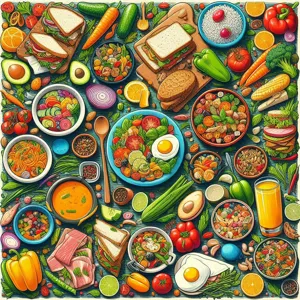In a world where sustainability and creativity collide, the art of transforming leftovers into culinary delights has never been more appealing.
We’ve all experienced the post-dinner dilemma of what to do with leftovers — tossing it in the fridge and hoping it magically disappears can feel wasteful and uninspired. But what if you could turn those forgotten remnants into mouthwatering meals that excite your palate and nourish your body? In this blog post, we’ll explore a variety of imaginative leftover makeovers that will elevate your dining experience, showcasing how simple ingredients can be reimagined into stunning dishes. From savory casseroles to vibrant salads and tantalizing wraps, get ready to unleash your inner chef and discover how to breathe new life into yesterday’s meals. Say goodbye to the mundane and hello to a world of delicious possibilities!
1. The Importance of Leftover Makeovers

In a world where culinary creativity meets sustainability, the importance of leftover makeovers cannot be overstated. Leftovers often carry with them the weight of yesterday’s meals, but with a little imagination and a touch of innovation, they can be transformed into delightful new dishes that tantalize the taste buds and reduce food waste.
Embracing leftover makeovers not only helps to stretch your grocery budget—it also fosters a sense of resourcefulness in the kitchen. Rather than letting uneaten portions languish in the fridge, you can breathe new life into them, turning the mundane into the extraordinary. Picture a simple roast chicken from last night’s dinner becoming a zesty chicken taco filling, or yesterday’s vegetable stir-fry morphing into a savory frittata brimming with flavor.
Moreover, reimagining leftovers can be an opportunity for culinary experimentation. This practice encourages you to explore flavors, textures, and combinations you might not have considered otherwise. It opens the door to creativity, inviting you to mix and match ingredients, spices, and sauces, resulting in dishes that are uniquely yours.
On a larger scale, prioritizing leftover makeovers is a step toward environmental stewardship. According to the Food and Agriculture Organization, a staggering one-third of all food produced globally is wasted. By transforming leftovers into new meals, you contribute to reducing this statistic, helping to minimize your carbon footprint while maximizing the joy of cooking.
Ultimately, the art of leftover makeovers is about more than just saving money or reducing waste—it’s about celebrating the potential of food and the joy of discovering new flavors. So, roll up your sleeves and get ready to transform what’s left into something that will make your taste buds dance!
2. Tips for Storing Leftovers Properly
When it comes to transforming your culinary creations into delightful leftover meals, proper storage is key to maintaining freshness and flavor while preventing food waste. Here are some essential tips for storing leftovers effectively:
**1. Cool Down Quickly:** To preserve the taste and texture of your dishes, allow leftovers to cool to room temperature before refrigerating. However, don’t leave them out for more than two hours to avoid the growth of harmful bacteria. If you’re in a hurry, consider dividing large portions into smaller containers to speed up the cooling process.
**2. Use Airtight Containers:** Invest in high-quality, airtight containers that can seal in moisture and prevent odors from mingling in your fridge. Glass containers are not only durable but also allow you to see what’s inside without opening them. Label each container with the contents and date to keep track of what you have and when it needs to be consumed.
**3. Portion Control:** Think about how you plan to use the leftovers. If you know you’ll only need a single serving, store them in single-portion containers. This not only makes reheating easier but also helps prevent overindulging and encourages mindful eating.
**4. Freeze for Future Enjoyment:** If you know you won’t be able to eat your leftovers within a few days, don’t hesitate to freeze them. Just make sure to use freezer-safe containers or bags. Label them with the name of the dish and the date so you can easily identify them later. Most meals can be frozen for up to three months without sacrificing quality.
**5. Reheat Safely:** When it’s time to enjoy your stored leftovers, ensure you reheat them to the appropriate temperature (165°F or 74°C) to kill any potential bacteria. Stirring your food while reheating ensures even warmth and prevents cold spots.
By following these tips for storing leftovers properly, you’ll not only extend the life of your meals but also set the stage for some truly creative and delicious transformations. Rediscovering yesterday’s favorites has never been easier or more enjoyable!
3. Understanding Flavor Pairings for Leftover Ingredients

When it comes to transforming leftovers into culinary delights, understanding flavor pairings is an essential skill that can elevate your dishes from mundane to mouthwatering. Each ingredient has its own unique profile, and discovering how to blend these profiles harmoniously can turn a simple leftover into a gourmet creation.
Start by considering the foundational flavor categories: sweet, salty, sour, bitter, and umami. For instance, leftover roasted vegetables can be revitalized with a splash of balsamic vinegar (adding a tangy-sweet note) and a sprinkle of feta cheese (introducing a salty creaminess). Similarly, if you have leftover chicken, try pairing it with citrus fruits like oranges or lemons to brighten the dish and cut through any richness. The zesty acidity of the citrus can rejuvenate the chicken, making it feel fresh and new.
Don’t overlook herbs and spices, either—they can be the magic touch that transforms your leftovers. Fresh basil or cilantro can infuse a dish with freshness, while spices like cumin or smoked paprika can add depth and warmth. For example, if you have leftover rice, consider sautéing it with onions, garlic, and spices to create a fragrant fried rice that feels entirely different from the original dish.
Experiment with contrasting flavors, as well. A sweet-tart fruit chutney can elevate savory meats, while a drizzle of honey or maple syrup can add a delightful sweetness to roasted root vegetables. Explore textures as well; the crunch of toasted nuts or seeds can add an exciting element to a creamy leftover soup or salad.
By understanding these flavor pairings, you’ll not only breathe new life into your leftovers but also expand your culinary repertoire. Embrace the creative process as you experiment and taste, and soon you’ll find yourself inspired to create delightful dishes that make the most of every ingredient in your kitchen!
4. Breakfast Makeovers: Turning Dinner into a Morning Feast
Breakfast is often hailed as the most important meal of the day, yet many of us find ourselves rushing through it, opting for quick and uninspired options. Why not elevate your morning routine by transforming last night’s dinner into a delicious breakfast feast? Embracing breakfast makeovers not only saves time but also sparks creativity in the kitchen.
Imagine waking up to the tantalizing aroma of a savory frittata brimming with leftover roasted vegetables and a sprinkle of cheese. Simply whisk a few eggs, pour them over your colorful medley of veggies, and bake until golden. The combination of flavors from the previous night’s dinner melds beautifully, creating a hearty dish that’s as satisfying as it is nutritious.
Alternatively, consider repurposing leftover grilled chicken or steak into a vibrant breakfast burrito. Sauté some onions and peppers, toss in your protein, and wrap it all up in a warm tortilla with a dollop of salsa and avocado. This not only adds a punch of flavor but transforms your dinner into a handheld morning delight that’s perfect for on-the-go.
For a sweet twist, leftover quinoa from dinner can be reimagined as a delightful breakfast bowl. Cook it with almond milk, a dash of cinnamon, and a touch of maple syrup for a nourishing start. Top it with fresh fruits, nuts, and a drizzle of honey, and you’ve got a dish that’s both filling and fabulous.
Embracing these breakfast makeovers not only minimizes food waste but also allows you to enjoy the bold flavors of your previous meals in a new and exciting way. So, the next time you find yourself with leftovers, don’t just reheat; think creatively and transform your dinner into a morning feast that will have everyone asking for seconds!
5. Lunch Innovations: Creative Sandwiches and Wraps

When it comes to repurposing leftovers, the humble sandwich or wrap presents a canvas bursting with culinary potential. Lunch innovations can elevate your leftover game from mundane to magnificent, transforming yesterday’s meals into today’s delightful creations.
Imagine taking last night’s roasted chicken and crafting a tantalizing chicken salad sandwich. Mix the shredded chicken with a dollop of Greek yogurt, a squeeze of lemon, finely chopped celery, and a sprinkle of fresh herbs. Layer it between slices of whole grain bread with crisp lettuce and ripe tomato for a satisfying crunch. The best part? You’ve not only saved time but also reduced food waste while enjoying a delicious meal.
Wraps offer an equally exciting avenue for leftover creativity. Consider a Mediterranean-inspired wrap featuring leftover grilled vegetables and hummus. Spread a generous layer of hummus on a whole wheat tortilla, then pile on the vibrant veggies, some crumbled feta, and a drizzle of balsamic glaze. Roll it up tightly and slice it in half for a portable lunch that’s as nutritious as it is flavorful.
Don’t hesitate to think outside the box! Leftover chili can be transformed into a hearty sandwich spread by mashing it with cream cheese or avocado, adding a spicy kick and making it spreadable. Or reinvent last week’s taco night with a breakfast wrap, incorporating scrambled eggs, beans, and cheese—all wrapped in a soft tortilla.
By reimagining your leftovers into innovative sandwiches and wraps, you not only create meals that are fresh and exciting, but you also bring a touch of creativity to your lunch routine. With a few simple adjustments, your leftovers can become the star of your next meal, delighting your taste buds and extending the life of your culinary creations. Embrace the art of lunch innovation and let your leftovers inspire a delicious and resourceful dining experience!
6. Transforming Leftover Proteins into New Dishes
Transforming leftover proteins into new dishes is an art that can elevate your meals from mundane to magnificent with just a dash of creativity. Whether it’s grilled chicken, succulent beef, or tender roasted fish, these proteins can serve as the perfect base for an entirely new culinary experience.
Start by shredding or chopping your leftover meats into bite-sized pieces. For instance, leftover roasted chicken can be transformed into a hearty chicken salad by mixing it with fresh greens, nuts, and a zesty vinaigrette. Alternatively, toss it into a warm grain bowl with quinoa, avocado, and a sprinkle of feta cheese for a nutritious lunch that feels freshly made.
Beef, on the other hand, can be repurposed into mouthwatering tacos. Just sauté some onions and peppers, add the diced beef, and serve it in soft tortillas with your favorite toppings like salsa, guacamole, and cilantro. The possibilities are endless!
If you have fish leftovers, consider creating a creamy seafood chowder or a flavorful fish cakes recipe. Combine the fish with breadcrumbs, herbs, and spices, and pan-fry until golden brown for a delightful appetizer or main dish.
Don’t forget about the flavor-boosting potential of sauces and spices. A simple stir-fry can breathe new life into any leftover protein. Just toss it in a hot pan with seasonal vegetables and your choice of sauce—think teriyaki, sweet chili, or a classic garlic-soy blend.
By thinking outside the box and experimenting with your leftover proteins, you’re not just minimizing waste; you’re also opening up a world of culinary possibilities. Each dish becomes a celebration of flavors, textures, and creativity, ensuring that your meals remain exciting and delicious long after the original feast has ended.
7. Creative Vegetable Utilization: From Sides to Salads

When it comes to leftovers, vegetables often get the short end of the stick. Those half-eaten roasted carrots, wilted spinach, or slightly overcooked green beans might not seem like much at first glance, but with a sprinkle of creativity, they can be transformed into vibrant culinary delights that breathe new life into your meals!
Instead of relegating these veggies to the back of the fridge until they succumb to the inevitable fate of spoilage, consider how you can repurpose them in exciting ways. One of the simplest transformations is turning leftover roasted vegetables into a hearty salad. Toss those colorful remnants with a base of fresh greens, add a handful of nuts for crunch, and drizzle with a zesty vinaigrette. The contrasting textures and flavors will not only elevate your dish but also make your leftovers feel like a fresh creation.
Another delightful option is to blend those vegetables into a creamy soup. Simply sauté some onions and garlic, add your leftover veggies, and pour in vegetable broth. Blend until smooth, and you have a comforting soup that’s packed with nutrients and flavor. If you’re looking for something a bit different, consider making vegetable fritters. Combine your leftover veggies with eggs, breadcrumbs, and your favorite herbs and spices, then pan-fry until golden brown. Serve them with a tangy yogurt sauce or a zesty salsa for an irresistible snack or appetizer.
Additionally, think about incorporating those veggies into wraps or sandwiches. Layer roasted vegetables with hummus and fresh herbs in a tortilla, or pile them onto whole-grain bread with a spread of goat cheese for a gourmet twist. The versatility of vegetables means that with just a bit of imagination, you can turn what might seem like mundane leftovers into a feast that dazzles the palate.
Embrace the challenge of creative vegetable utilization and watch as your leftover sides transform into enticing salads and innovative dishes that not only reduce food waste but also ignite your culinary creativity. After all, in the world of cooking, sometimes the best ideas come from what you already have on hand!
8. Innovative Uses for Leftover Grains and Pasta
Leftover grains and pasta are often the unsung heroes of the kitchen, waiting patiently in the fridge for a second chance to shine. With a little creativity and a dash of inspiration, you can transform these humble remnants into culinary delights that excite your palate and reduce food waste.
Consider the versatile world of grains first. Whether you have a bowl of quinoa, brown rice, or farro, these can be easily repurposed into a vibrant grain salad. Toss them with fresh vegetables, nuts, and a zesty vinaigrette for a refreshing lunch that packs a nutritional punch. For a heartier option, mix grains with sautéed onions, garlic, and seasonal vegetables to create a delicious grain bowl, topped with a poached egg or your favorite protein for added richness.
Pasta, too, holds endless potential beyond its initial meal. Leftover spaghetti or penne can be transformed into a delightful frittata. Simply whisk together eggs, add your pasta, some cheese, and any veggies you have on hand, then bake until golden and set. This dish is perfect for brunch or a quick weeknight dinner. Alternatively, consider making a creamy pasta bake by layering your leftover noodles with a homemade or store-bought sauce, a sprinkle of cheese, and a few herbs before popping it into the oven for a bubbly, comforting dish that the whole family will love.
Another innovative approach is to turn leftover grains or pasta into fritters or patties. Combine your grains or pasta with eggs, breadcrumbs, and grated cheese, then shape them into patties and pan-fry until crispy. Serve them with a dollop of yogurt or a tangy dipping sauce for a delightful appetizer or snack.
By thinking outside the box, you can breathe new life into your leftover grains and pasta, creating meals that are not only delicious but also sustainable. Embrace the challenge, and let your creativity flourish in the kitchen!
9. One-Pot Wonders: Simplifying Leftover Transformation
When it comes to transforming leftovers into something extraordinary, one-pot meals are your best friend. These culinary wonders not only save time but also minimize cleanup, allowing you to focus on flavor and creativity rather than the hassle of multiple dishes. Imagine taking yesterday’s roasted chicken, a handful of wilted greens, and some lingering grains, and turning them into a hearty, comforting stew, all in a single pot!
The beauty of one-pot wonders lies in their versatility. Start with a base of broth or sauce—perhaps a rich chicken stock or a fragrant coconut curry—and toss in your leftovers. As they simmer together, the flavors meld beautifully, creating a dish that feels entirely new. Add in some fresh herbs or spices to elevate the taste, and you’ve taken your simple leftovers to a restaurant-quality level.
Consider a classic risotto, where you can use up leftover vegetables and proteins. The slow cooking process allows the flavors to infuse, and the creamy texture makes it feel indulgent, even when it’s made from what’s left in your fridge. Alternatively, a stir-fry is another fantastic option: just grab that last bit of protein, toss in some colorful veggies, and your go-to sauce for a quick, vibrant meal that’s packed with nutrition.
Not only do these one-pot creations help you minimize food waste, but they also encourage you to experiment and adapt recipes based on what you have on hand. This is where culinary creativity truly shines. The next time you find yourself with an array of leftovers, remember: with a little imagination and a trusty pot, you can whip up a mouthwatering dish that brings new life to yesterday’s meals!
10. Spicing It Up: Using Sauces and Seasonings for Flavor
One of the simplest yet most effective ways to breathe new life into leftover meals is by spicing them up with a variety of sauces and seasonings. A dash of creativity in the condiment aisle can transform yesterday’s mundane dish into a mouthwatering delight that feels entirely new.
Start by assessing your leftovers—whether it’s roasted vegetables, grilled chicken, or a simple pasta dish—and think about what flavors might complement or contrast the existing ingredients. Have some chili sauce on hand? A few spoonfuls can add a fiery kick to your bland stir-fry. Feeling adventurous? Try a drizzle of tahini or a dollop of pesto to elevate a grain bowl into something vibrant and flavorful.
For those who love a bit of tang, citrus-based sauces or vinegars can do wonders. A splash of balsamic reduction can invigorate a sad salad, while a squeeze of lemon can brighten up a hearty stew. Don’t forget to experiment with herbs and spices! A sprinkle of smoked paprika or a handful of fresh cilantro can completely change the profile of your dish, making it feel gourmet rather than leftover.
Moreover, think about creating homemade sauces tailored to your taste. A quick blend of yogurt, garlic, and herbs can serve as a creamy dressing for roasted veggies, while a simple mix of soy sauce, honey, and garlic can turn plain rice into a savory base for a stir-fry.
The key is to have fun and be bold with your flavor choices. With a little imagination and the right seasonings, you can transform your leftovers from last night into today’s culinary masterpiece, proving that great meals can come from the remnants of yesterday’s creativity!
11. Kid-Friendly Leftover Recipes: Making Meals Fun
When it comes to transforming leftovers into exciting meals for kids, creativity is your best ally. Children can be notoriously picky eaters, often turning their noses up at yesterday’s dinner. However, with a little imagination, you can breathe new life into those remnants and make mealtime a fun, engaging experience.
Start by turning leftover proteins into playful shapes. For example, leftover chicken can be shredded and transformed into delightful chicken tacos with colorful toppings, turning a mundane meal into a make-your-own fiesta. Use small cookie cutters to create fun shapes from leftover vegetables, making them more appealing. Think of carrot stars or cucumber hearts that can be tossed into salads or served as finger foods.
Another great idea is to involve your kids in the cooking process. Create a “leftover pizza night” where they can choose from an array of leftover ingredients to top their individual pizzas. This not only sparks their creativity but also gives them a sense of ownership over their meal. You can even make mini pizzas with leftover pasta or rice, spreading the base with sauce and letting kids choose their favorite toppings.
Don’t forget about the power of soups! Combine various leftover vegetables, grains, and proteins into a vibrant, hearty soup. Let your kids assist in the cooking process, adding veggies and stirring the pot. You can even let them name their creations, which adds an element of fun and engagement.
Finally, consider creating fun snack platters featuring leftover ingredients. Use colorful bowls to arrange items like cheese cubes, cut-up fruits, and remnants of cooked meats. The visual appeal of a well-presented platter can entice even the pickiest eaters and encourage them to try new combinations.
By making meals fun and interactive, you not only reduce food waste but also foster a positive relationship with food in your children, ensuring they look forward to what’s on the table—even if it’s made from leftovers!
12. Freezing Leftovers for Future Culinary Delights
Freezing leftovers is a fantastic way to extend the life of your meals while also sparking creativity in the kitchen. Imagine opening your freezer and finding a treasure trove of delicious possibilities waiting to be transformed into something new and exciting! By taking a few moments to package your leftovers properly, you can set the stage for future culinary delights that will not only save you time but also reduce food waste.
Start by using airtight containers or heavy-duty freezer bags to prevent freezer burn and maintain flavor. Label each container with the date and contents, so you can easily identify what you have on hand. Consider portioning out meals in sizes that suit your lifestyle, whether you’re cooking for one or a family.
When it’s time to unleash your frozen creations, think beyond just reheating. Leftover roast chicken can be shredded and tossed into a hearty soup or transformed into spicy chicken tacos. A bit of extra chili can become a zesty chili con carne for a cozy night in, while leftover pasta can be baked into a creamy pasta casserole that will delight your taste buds.
Additionally, don’t overlook the power of combining leftovers. A medley of vegetables can be blended into a vibrant smoothie or sautéed for a flavorful stir-fry. The key is to let your imagination run wild! With a little creativity, your frozen leftovers can evolve into culinary masterpieces, proving that great meals don’t always have to start from scratch. So, embrace the art of freezing and let those leftovers inspire your next delicious dish!
13. Leftover Makeover Challenge: Get Creative!
Are you ready to unleash your culinary creativity? The Leftover Makeover Challenge is a fun and engaging way to turn yesterday’s meals into spectacular new dishes that will wow your family and friends. The beauty of this challenge lies in its simplicity: all you need are your leftovers and a dash of imagination!
Start by surveying your fridge and pantry for those overlooked ingredients. Leftover roasted chicken? Transform it into a zesty chicken salad with fresh herbs and a tangy dressing. Stale bread? Craft a comforting bread pudding or a savory strata layered with cheese and vegetables. The key is to think outside the box and consider different cuisines and flavor profiles.
Challenge yourself to incorporate at least three leftover items into a single dish. Maybe that half a cup of quinoa can become a vibrant bowl of grain salad, tossed with seasonal veggies and a splash of lemon. Or perhaps those last few slices of pizza can be reimagined into a gourmet breakfast frittata with eggs and cheese.
Don’t forget to document your culinary adventures! Share your creations on social media using a unique hashtag, encouraging others to join in the fun. This not only inspires creativity but also builds a community around the art of repurposing food.
So, gather your leftovers, roll up your sleeves, and let the Leftover Makeover Challenge begin! Who knows? You might just discover your new favorite dish lurking in the depths of your fridge, waiting to be transformed into a culinary delight!
14. Stories from Home Cooks: Successful Leftover Transformations
In the world of culinary creativity, there’s nothing quite as inspiring as the stories of home cooks who have mastered the art of transforming leftovers into delightful new dishes. These tales are more than just recipes; they are a testament to resourcefulness, innovation, and the love of good food.
Take Lisa, for example, a mother of three who, after a busy week of meal prepping, found herself staring down a mountain of leftover roasted vegetables and quinoa. Instead of letting them languish in the fridge, she decided to whip up a vibrant Mediterranean grain bowl. With a sprinkle of feta cheese, a drizzle of olive oil, and a handful of fresh herbs, Lisa turned what could have been a mundane meal into a colorful feast that her kids now request weekly.
Then there’s Marco, an aspiring chef who accidentally overcooked a large batch of chicken. Rather than relegating it to the dreaded “microwave meal” status, he shredded the leftover chicken and tossed it with a homemade BBQ sauce, turning it into mouthwatering pulled chicken sandwiches. The result? A family barbecue that became the highlight of their summer, with neighbors begging for his secret recipe.
These stories resonate because they remind us that cooking is not just about sustenance; it’s about creativity and connection. When home cooks innovate with their leftovers, they’re not only minimizing waste but also weaving memories around the dinner table. Whether it’s a savory frittata made from last night’s pizza or a sweet bread pudding crafted from stale pastries, each transformation is a unique expression of love and culinary exploration.
So, the next time you find yourself with an array of leftovers, remember these home cook heroes and let their stories inspire your own culinary adventures. Embrace the challenge of reimagining your meals; you never know what delicious delights await just a few creative tweaks away!
15. Conclusion: Embracing Leftovers as a Culinary Opportunity
In conclusion, embracing leftovers as a culinary opportunity is not just a practical approach to reducing food waste; it’s a gateway to creativity and innovation in the kitchen. Rather than viewing yesterday’s meals as mere remnants, see them as a blank canvas waiting for your artistic touch. With a little imagination, those leftover ingredients can be transformed into vibrant new dishes that tantalize the taste buds and inspire joy at the dining table.
By experimenting with flavors, textures, and presentation, you can elevate even the simplest of leftovers into something extraordinary. Whether it’s repurposing roasted vegetables into a hearty frittata, turning last night’s pasta into a zesty salad, or creatively using stale bread for a delicious bread pudding, the possibilities are endless.
Moreover, embracing this mindset not only allows you to save money and reduce waste but also encourages a deeper connection with your food. It invites you to appreciate the value of each ingredient, to be resourceful, and to celebrate the art of cooking. So, the next time you find yourself staring at a container of leftovers, remember that it’s not just food waiting to be eaten; it’s an opportunity to create something delightful. Dive in, get inspired, and let your culinary creativity shine!






